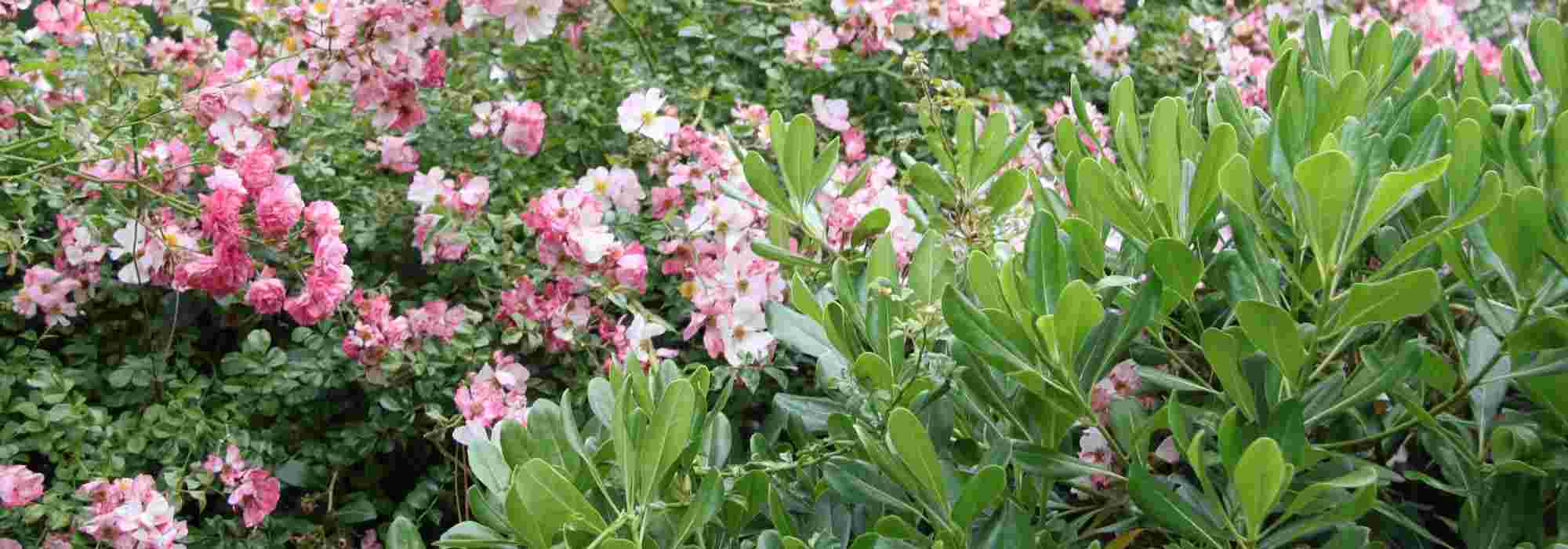
Pittosporum: 5 ideas for successful plant combinations
Discover our ideas and inspirations!
Contents
Pittosporum is an elegant bush, somewhat tender, preferring mild climates. It is highly valued for the beauty of its evergreen foliage which remains decorative throughout the year and for the scent of its spring flowering, reminiscent of orange blossom.
It offers a fine diversity of foliage: glossy green in Pittosporum tobira, glaucous or purple in ‘Tom Thumb’ or variegated in ‘Elisabeth’, allowing combinations with a range of bushes. This plant, well adapted to maritime climates, is widely planted as hedging on our Mediterranean and Atlantic coasts. The most compact varieties are well suited to container cultivation.
Discover how to combine Pittosporum with other plants in the garden!
In a Mediterranean hedge
Pittosporum makes a very attractive feature in a hedge with a fairly natural, country-style habit, composed of a wide variety of species. It is well suited to creating informal hedges in mild climates. And because it tolerates sea spray perfectly, you can use it without reservation in an evergreen hedge by the sea that will screen your garden from view all year round, even in winter.
Choose the larger Pittosporum, which commonly reach up to 3 to 4 m when not pruned. Don’t hesitate to vary the colours by combining the bright, glossy green of Pittosporum tobira and Pittosporum heterophyllum with the very bright variegated foliage of Pittosporum tenuifolium ‘Abbotsbury Gold’ and Pittosporum tenuifolium ‘Variegatum’. Pair it with other Mediterranean bushes such as oleanders, Elaeagnus, Callistemon or Russian olive (Elaeagnus angustifolia).
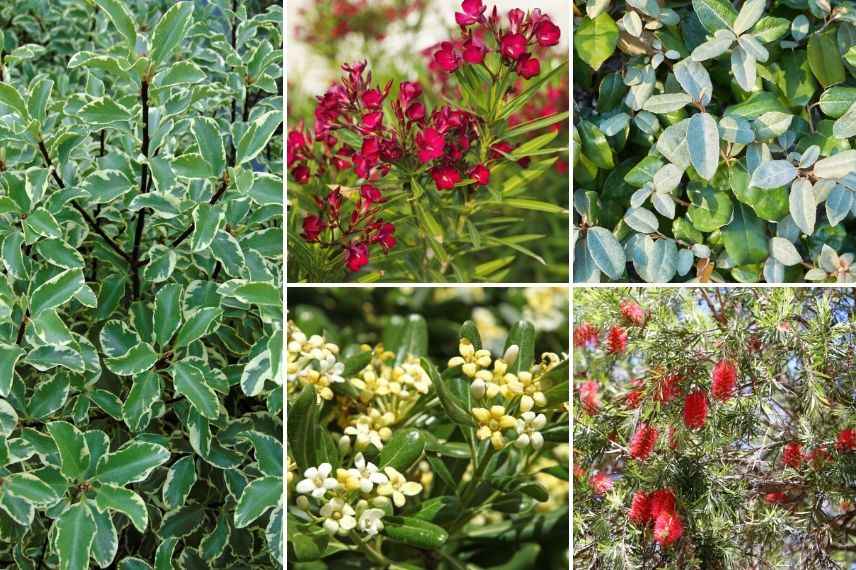
An example of a hedge combination: Pittosporum tenuifolium ‘Variegatum’, Nerium oleander, Elaeagnus ebbingei, Pittosporum heterophyllum and Callistemon
By the sea, it will be accompanied by Pistacia lentiscus, Griselinia littoralis, Olearia and Escallonias. Choose bushes that flower at the same time as Pittosporums, such as Mexican orange or Elaeagnus umbellata. Smaller varieties can be combined with other bushes for low hedges, such as Abelias.
To brighten a rock garden
Pittosporums of modest size and compact habit are well suited to use in rockeries to which they add structure and plenty of brightness. The P. tenuifolium ‘Thom Thumb’ is a handsome compact variety that bears dark, intensely bronze-violet foliage with metallic reflections and scented flowering. In mild climates, it is perfect for bringing an exotic touch to a large sunny, arid rockery. Its purple foliage will provide a striking contrast with the bright yellow flowering of Cytisus decumbens, or creeping broom. Accompany it with hardy geraniums, grevilleas, a Cistus (x) loretii with white flowers adorned with beautiful brown-purple maculate spots, and other scented plants (lavender, rosemary…). Scatter a few clumps of silvery-leaved artemisias.
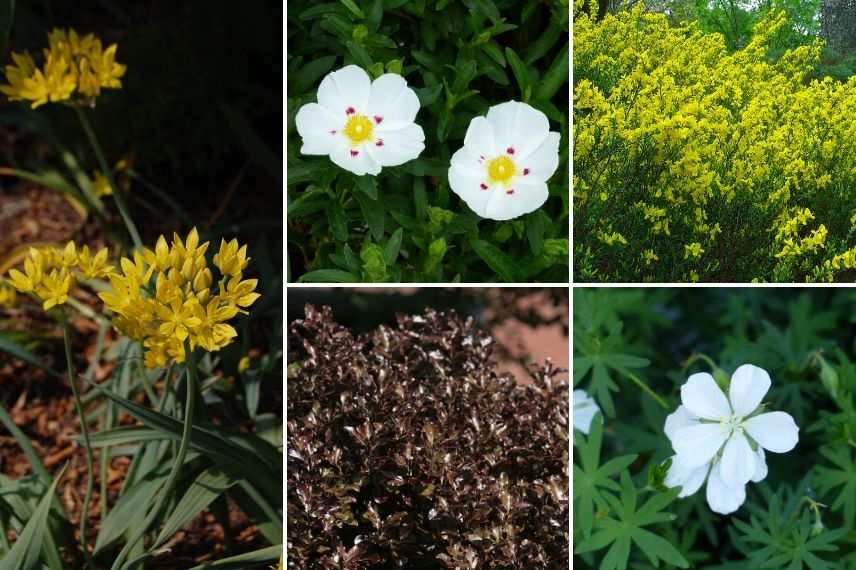
Example of a rockery planting: Allium moly, Cistus x loretii, Cytisus decumbens, Pittosporum ‘Tom Thumb’ and Geranium sanguineum ‘Album’
Discover other Pittosporum
View all →Available in 0 sizes
Available in 1 sizes
Available in 1 sizes
Available in 2 sizes
Available in 2 sizes
Available in 1 sizes
Available in 3 sizes
Available in 2 sizes
Available in 1 sizes
Available in 2 sizes
To structure a flower bed
Pittosporum is an ideal bush for structuring a border elegantly. Some varieties with a compact habit such as Pittosporum tenuifolium ‘Golf Ball’ and ‘Golden Ball’ make excellent replacements for boxwood. Their compact growth and rounded habit make them easy to train as topiary or to form a small, formal-looking hedge. With their small olive-green leaves, or yellow leaves marginate with acid green, attractive year-round, once pruned these compact pittosporums add volume. They prove invaluable for structuring a planting composed of plants with more spontaneous forms such as shrubby red or fuchsia sages, grevilleas, santolinas, or Prostanthera or Australian mint. For best effect, do not plant them in a straight line but in a staggered layout for a more natural look in the border.
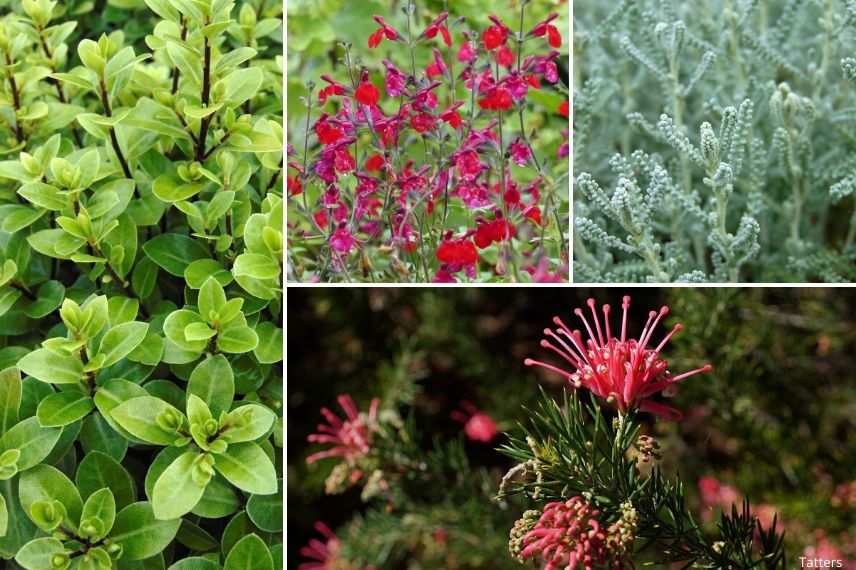
An example of a border planting: Pittosporum ‘Golf Ball’, Salvia ‘Rêve Rouge’, Santolina chamaecyparis, Grevillea juniperina
Read also
How to plant a hedge?Standalone
If you are looking for a Pittosporum capable of becoming a genuine focal point in your Mediterranean garden, choose without hesitation the Pittosporum tenuifolium ‘Irène Patterson’, a cultivar with almost snowy foliage. Plant it, for example, in a dry garden in the medium of a short grass meadow, on a large bank, or close to the house. It offers a magnificent display all year round with its very glossy foliage, speckled with silver and variegated with white and almond green, often tinged with pink in winter. In spring, when its delicately scented purplish-violet flowers appear, it is utterly beguiling! Pair it with the silver foliage of small artemisias or Stachys. You can also showcase it by placing just a few groundcover plants at its base, for example mignardise carnations, the Lychnis coronaria ‘Gardener’s World’ with semi-evergreen silvery-grey foliage and small bright pink flowers.
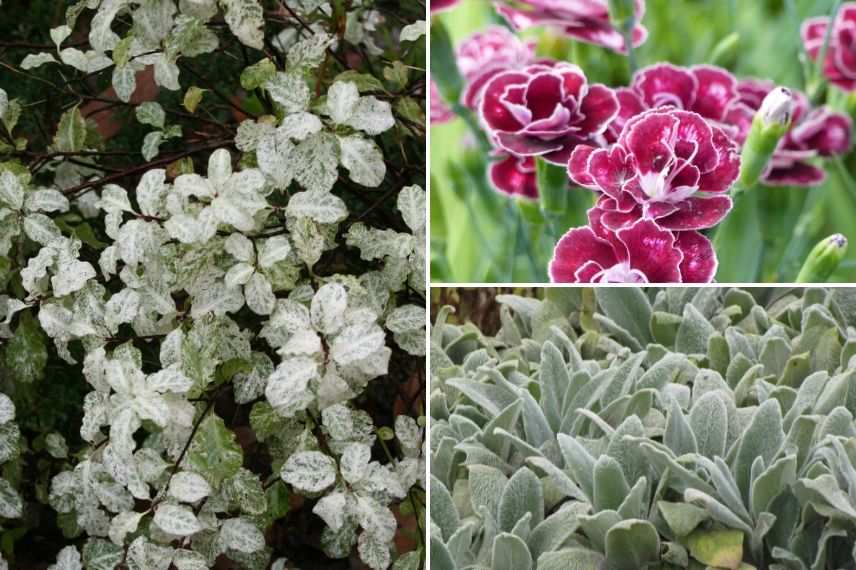
An example of a solitary grouping: Pittosporum tenuifolium ‘Irene Patterson’, Dianthus allwoodii ‘Romeo’ and Stachys byzantina ‘Silver Carpet’
In a container, on a patio or in a small garden
Tender pittosporums are best grown in pots (to overwinter) when winter climate is too cold. A real boon if you have limited space! Choose the most compact, low-growing varieties, such as the Pittosporum tobira ‘Nanum’, it does not exceed 1 m in height! This dwarf variety will bring an evergreen touch to your terrace or balcony. Very floriferous, it is covered in white flowers in spring, with orange blossom fragrance and will provide a lovely display. The Pittosporum tenuifolium ‘Silver Ball’ is also perfectly suited to ornamenting terraces and small gardens. Pair them with small aromatic plants such as lavender, thymes or rosemary that you will also grow in pots nearby.
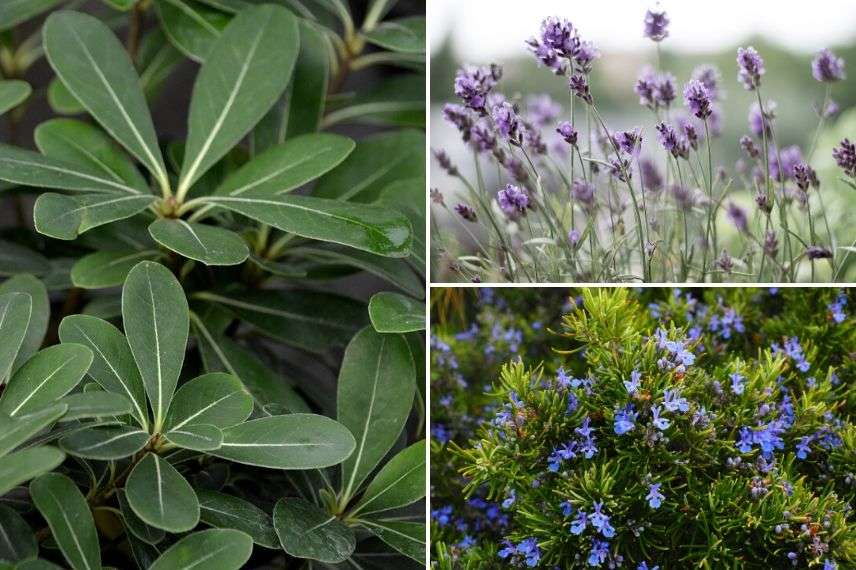
An example of a pot combination: Pittosporum tobira ‘Nanum’, Lavender and Rosemary
To learn more
- Full factsheet : Pittosporum: to plant, to grow and to prune
- Advice sheet : How to choose the right Pittosporum?
- Subscribe!
- Contents
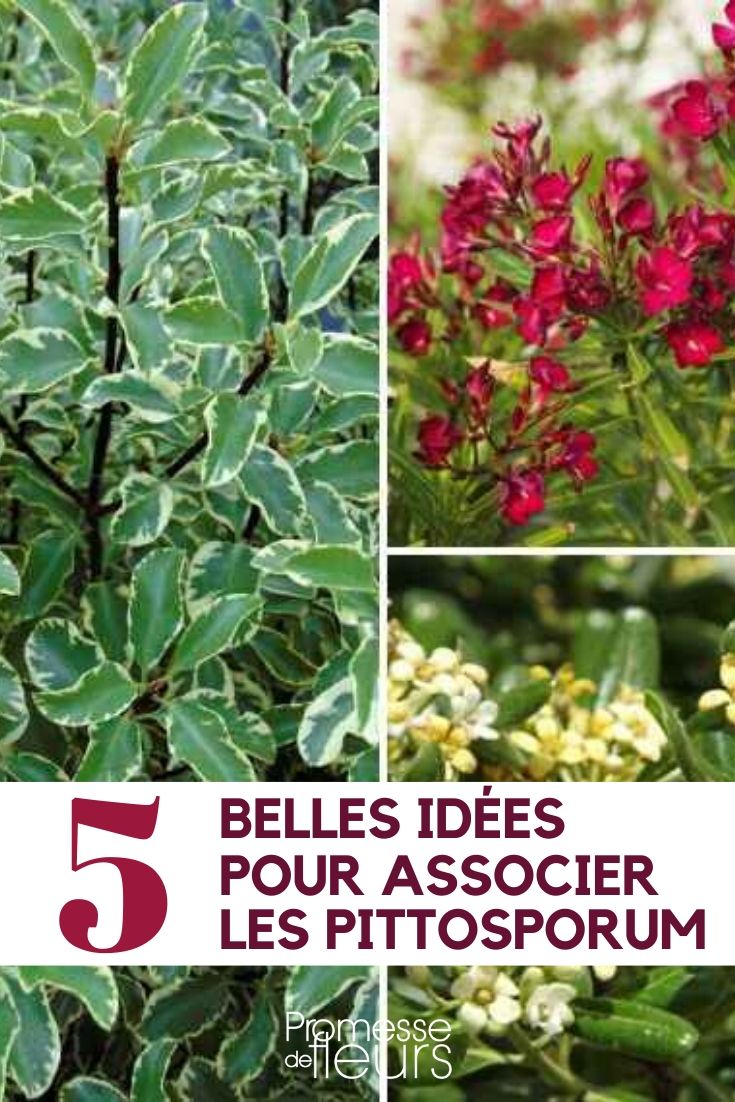































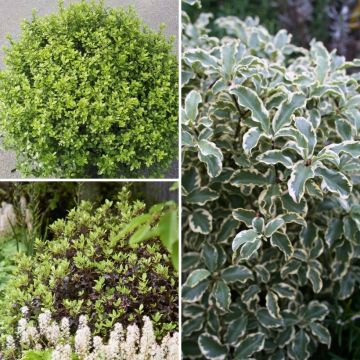
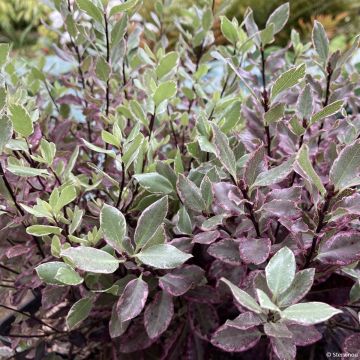
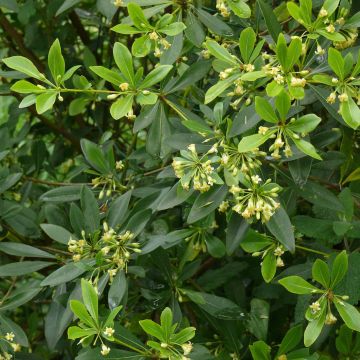
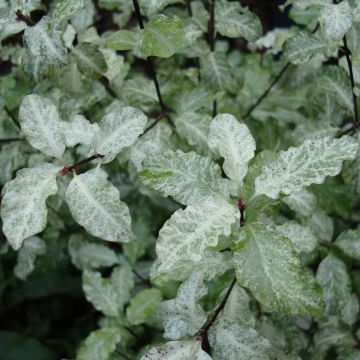
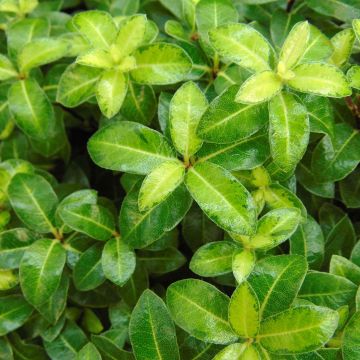
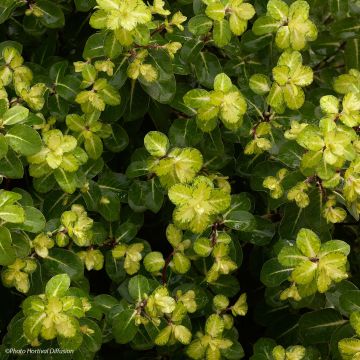
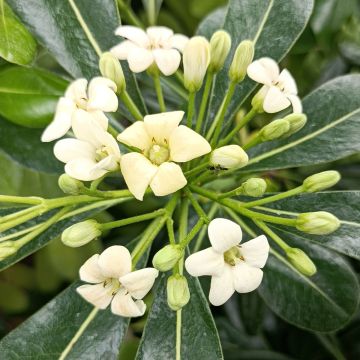
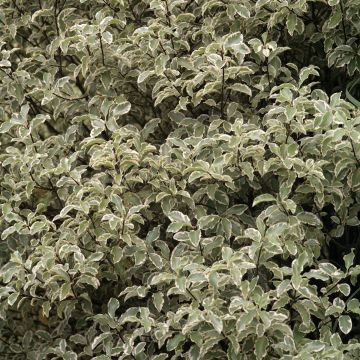
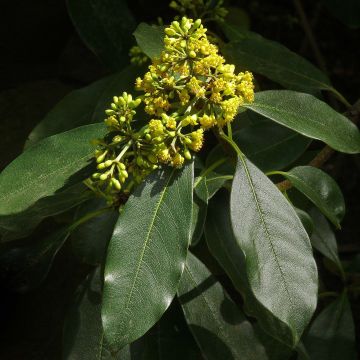

Comments